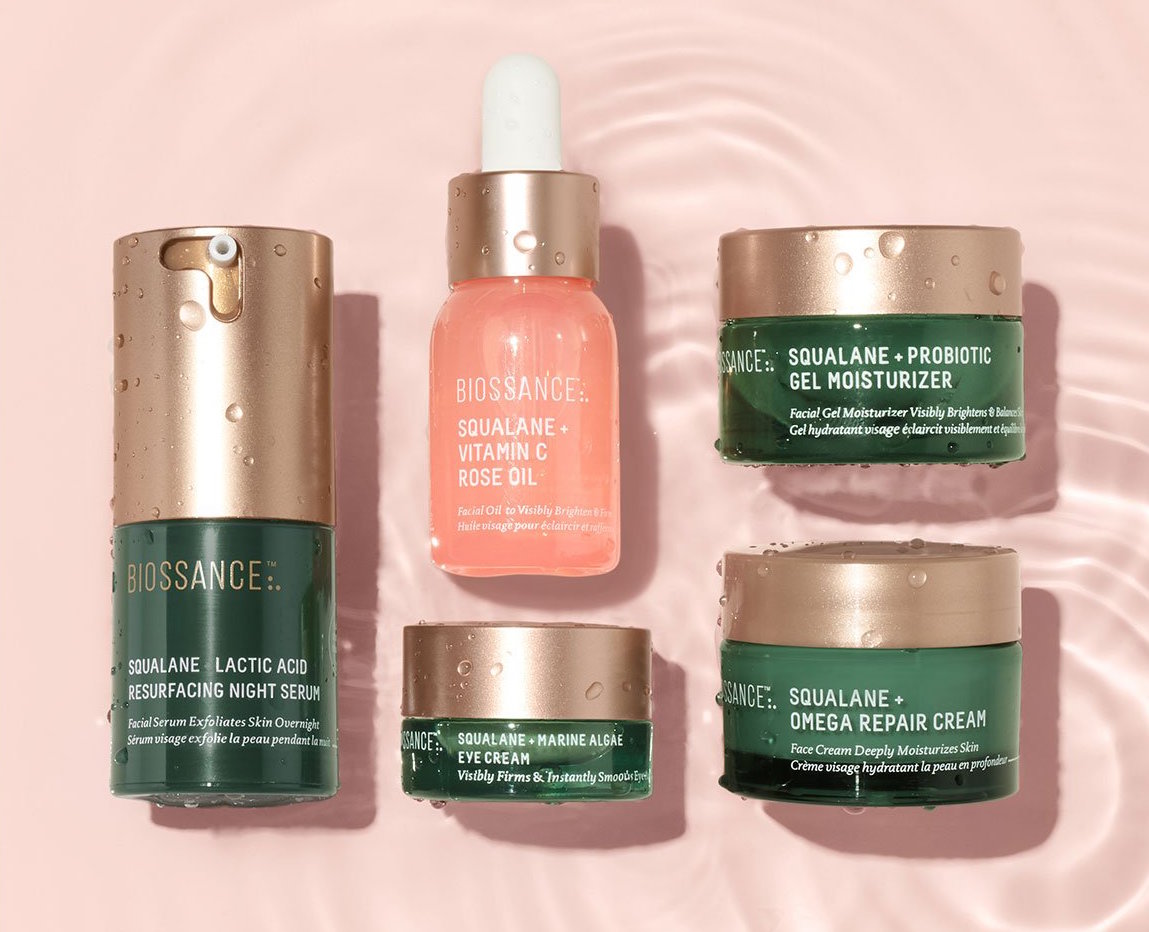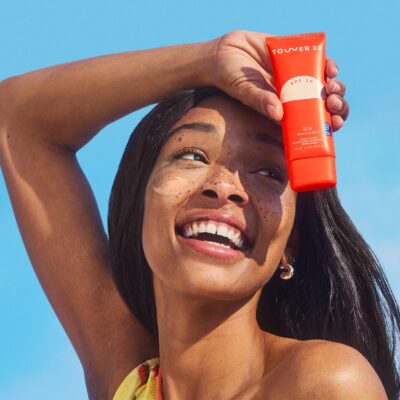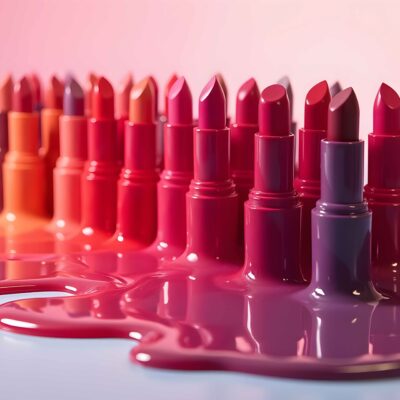
“Bargain Basement”: The Beauty Industry Reacts To THG’s Biossance Acquisition
Biossance, the brand that raised awareness of Amyris’s lab-brewed squalane, has found a new home.
THG Beauty, also known as The Hut Group, snapped up the brand for $20 million in a bankruptcy auction marked by what Matthew Moulding, founder and CEO of the British e-commerce company, described as lackluster enthusiasm. “Usually, there’d be a queue of buyers for a brand like Biossance — a large, premium, clean chemistry brand, with sustainability at its core,” he said in a recent LinkedIn post. “Over 50% of sales are generated from Biossance’s own website, and it has a major US store agreement with SEPHORA. But buyer interest was minimal. The only other serious bidder was a US PE firm.”
Despite the poor reception, Moulding is convinced Biossance can have a positive impact on The Hut Group. “Biossance should be immediately breakeven in THG,” he wrote. “Our US and UK labs will support with manufacturing, and [e-commerce platform] THG Ingenuity immediately brings both a new global website & distribution.”
Biossance was widely considered to be the most valuable asset in biotechnology parent company Amyris’s consumer brand portfolio, with its 2022 revenues closing in on $100 million. In addition to Sephora, the skincare brand secured retail partnerships with Sephora UK, Douglas, Selfridges, Harrods, Space NK, Cult Beauty and Lookfantastic, the latter two of which are owned by The Hut Group. However, spiraling costs eroded the brand’s sales significantly, and it incurred $90 million in losses last year, per Moulding’s post.
Amyris filed for bankruptcy in August, putting the brands Biossance, JVN, Rose Inc, Pipette, Menolabs, 4U By Tia and Stripes on the chopping block. Other assets, including Teresana, Olika, EcoFabulous, Pure Cane, Beauty Labs, Costa Brazil and Onda Beauty, were shuttered ahead of the filing.
The clean beauty retailer Onda Beauty reopened in October after co-founder Larissa Thomson purchased it for $220,000. The same month, the publication The Business of Fashion reported that Costa Brazil founder Francisco Costa’s company FCIP Holdco made a bid to buy back the eco-friendly fragrance and body care brand for $350,000.
Along with The Hut Group, Scent Theory Products purchased Tia Mowry-linked haircare brand 4U By Tia out of auction for $600,000, Dr. Reddy’s Labs scooped up menopause product specialist Menolabs for $3 million and HRB Brands nabbed mom and baby skincare brand Pipette for $1.75 million. The fates of Jonathan van Ness-affiliated haircare brand JVN, Naomi Watts-affiliated menopause solution brand Stripes and Rose Huntington-Whiteley-affiliated cosmetics brand Rose Inc remain unclear.
THG Beauty’s sluggish sales and rising costs have pushed it to lower sales guidance for the year. Its pre-tax losses were 133 million pounds or approximately $167.4 million in the period ending June 30, an uptick from 108 million pounds or approximately $135.9 million in the same year-ago period. Its revenue for the period was down 9.3% to about 969 million pounds or approximately $1.2 billion. Operating losses soared 261% in 2022, totaling 495 million pounds or approximately $622.9 million.
In addition to online beauty retailers Cult Beauty and Lookfantastic, THG Beauty owns Dermstore, SkinStore, Eyeko, Illamasqua, Espa, Glossybox, Grow Gorgeous, Ameliorate, Acheson & Acheson, RY, Christophe Robin and Perricone MD. The company’s website estimates that it sells 1,300 premium beauty brands in the skincare, haircare, cosmetics and fragrance categories across 195 territories.
As Biossance integrates with its new owner, we were curious about the beauty industry’s reaction to the deal. So, for the latest edition of our ongoing series posing questions relevant to indie beauty, we asked nine investors, strategists and brand builders the following questions: What’s your take on The Hut Group acquiring Biossance? Will it help to resuscitate its business? What company will scoop up JVN, Rose Inc and Stripes, and what does interest or lack thereof in these brands say about the state of celebrity beauty brands?
- Diana Melencio General Partner, XRC Ventures
In the case of THG, financially, I think there are some clear synergies and reasons for the purchase. Biossance generated $10 million in profit last year (from a $100 million revenue base) and, presuming synergies and efficiencies from supply chain and distribution, the payback on the $20 million payment is made back after several years.
That said, there's a reason why other strategics didn't offer bids, and therefore we saw a $20 million price tag. Biossance isn't differentiated enough, which was evident in their marketing spend.
I don’t think it will help THG’s beauty business. Given the current channel distribution, I don't believe that ownership of a brand will drive traffic to their online marketplaces nor will their marketplaces be a driver for Biossance, who is already across multiple retailers and marketplaces, including Sephora and Amazon.
As far as JVN, Rose Inc and Stripes, the price has to be "right." I am hearing from strategics that they're focused on M&A characteristics of: IP (Olaplex, K18), profitability or a demographic to capture that they are not serving with their current roster of brands.
I do not believe there is a strong case for differentiation on those factors for JVN, Rose Inc and Stripes. Thus, I don't think we'll see a strategic exit for them, but a PE one potentially and at low valuation multiples.
Celebrity brands are going out of favor. There are very few celebrities that can drive sales in the way that Kim Kardashian or Selena Gomez do. For others without the same reach and fan engagement, the "celebrity" doesn't translate to sales.
And, when the star falls out of favor with the audience, it has a direct impact on the viability of the company, a large reason why strategics don't often, with few exceptions, acquire these brands.
- Janet Milner-Walker Founder and Managing Director, Bespoke Advantage
This is interesting, for several reasons. From the brand’s perspective, their parent company, Amyris, who filed for Chapter 11 bankruptcy, invested significantly in building Biossance, to the tune of $300 million to $400 million, with $200m alone invested in brand marketing.
Leading celebrity Reese Witherspoon was their brand ambassador, they had a strong e-commerce channel that generated over 50% of their sales, and relationships with key retailers including Sephora in the U.S., and Selfridges, Harrods, SpaceNK and Sephora in the U.K. They were also sold through Lookfantastic and Cult Beauty, part of THG, with THG already generating $2 million in sales from the brand.
THG were familiar with the success of the brand. When it became known that the brand was up for sale, naturally THG was interested, and thanks to their Ingenuity platform, they were well placed in terms of infrastructure and resources to bid for the brand.
THG have been through a number of challenging times, posting lower half-year results for 2023, citing inflationary pressures over the past 18 months, along with global destocking impacting their manufacturing volumes. That said, they have a strong brand portfolio, both on the nutrition and the beauty side of their business, with brands including Perricone MD and Espa as well as a strong brand portfolio across Cult Beauty and Lookfantastic.
Biossance is a great complement to their current portfolio as a clean, prestige skincare brand. Not often does a U.K. company have the opportunity to acquire a well-positioned, successful U.S. skincare brand with a powerful base in the US market.
They were fortunate to scoop up the brand for $20 million, less than the value of the stock they acquired as part of the sale, which was $23 million plus $6 million receivables. Since the announcement, their share price has risen 1% to 78.84 pence in London, which is a positive sign.
It is difficult to say who may buy these celebrity brands. The celebrities themselves may decide to take over the brand. Coty is renowned for buying into celebrity brands, but generally when they are the licensee, and they have built the brand together with a celebrity.
JVN Hair is a collaboration between Jonathan Van Ness and Amyris launched as a clean hair care brand. Haircare is performing well as a category and is a growth sector, so it will be interesting to see who comes forward to invest in the brand. Numerous multinationals may be looking to add another hair care brand to their portfolio.
Rose Inc is a collaboration between Rosie Huntington-Whitely and Amyris, a cosmetics brand that is stocked in several leading retailers including SpaceNK and Cult Beauty and receives positive reviews on their products and formulations.
Stripes is a collaboration between Naomi Watts and Amyris, a menopause brand, which only launched at the end of last year across a number of retailers including Sephora and Amazon. Menopause is a hot topic at the moment, and Naomi, at 54, is a great ambassador for the brand.
Naomi Watts had another brand, Onda Beauty, also launched through Amyris, which was closed down and then acquired by one of the other co-founders, Larissa Thomson. Naomi didn’t return to the helm of the brand.
Over the past few years, numerous celebrities have launched into the beauty and wellness industry, and some with greater success than others. Rihanna’s Fenty Beauty and Selena Gomez’s Rare Beauty have been amongst the success stories.
However, the challenges we have experienced over the past few years have had an impact on rising costs of goods and inflation coupled with consumer demand for authenticity, transparency and being part of a community, they have become far more skeptical about false reviews. All of this has an impact on sales, so brands need to deliver in terms of product, marketing and building direct and authentic relationships with their customers. It isn’t enough to put a celebrity name to a product anymore.
- Tina Bou Saba Co-Founder and Co-Managing Director, Verity Venture Partners
Biossance was arguably the crown jewel of the Amyris brand portfolio. Biossance has a strong brand and the products are high-quality. That said, at the reported $20 million sales price, I think it's safe to assume that this brand traded at a significantly lower multiple of revenue than we typically expect for scaled prestige skincare brands.
It is difficult to know how much Amyris's broader struggles over the past year contributed to individual brand performance, but I imagine that there was some material negative impact. As a result, the Biossance business may have contracted in the months preceding this sales process, which, of course, creates a difficult dynamic for the seller.
THG is a complex business that has had its own challenges over the past couple of years, so it's hard to determine what impact this acquisition will have on its broader business. I suppose that buying Biossance at a discount and putting it on the THG platform will be potentially accretive, but unlikely transformative, for THG's beauty business.
It is indeed intriguing that, while Menolabs and Pipette transacted, JVN, Rose Inc and Stripes did not. I don't know why this is the case, but I imagine that the complexity of negotiating a crucial celebrity contract in the midst of a bankruptcy auction process gave many potential buyers pause.
In my opinion, this does not reflect declining consumer interest in celebrity or influencer brands. Rather, it is a somewhat tragic demonstration of how little a celebrity brand is worth without the celebrity. If anything, I think that this outcome will lead celebrity and influencer brand founders to be more circumspect when evaluating potential partners. They will take care to ensure that prospective partners and/or parent companies have healthy financials and sustainable business models.
- Stephen Letourneau Chief Brand Officer and Founder, BFYW
THG's acquisition of Biossance is a signal to the community as a whole that THG is going to refocus and reset their beauty business. We are all hoping that they will revive their previous reputation of being a partner to brands leading innovation and evolving the space. We are all missing that version of the company.
Looking at the most recent departure of celebrity-led brands to close, it is becoming more and more apparent that the educated beauty buyer is looking for brands from skincare professionals and MUAs, in general people with passion surrounding the product being made.
Historically, we have seen established brands layer in a celebrity spokesperson for a nominal boost in sales. Fenty Beauty via partnership with LVMH has really been the outlier in this instance. Not to discount SKKN, but the halo effect of Kim Kardashian is simply not going to be replicated. That said if Taylor Swift wants to collab, I'd give a it go with her team!
I’m curious to see which firms coming out of cannabis M&A will step in to pick up these beauty brands as that market transitions from cannabis to plant-based wellness, assuming the lure of celebrity following will allow for these funds to optimize the under-capitalized brands and bring them back to the main stage. If this happens we will see a new wave of celebrity crossover brands in both spaces. I cannot wait to see which brand gets picked up first.
- Wizz Selvey Founder, Wizz&Co
It’s a wise move for the THG to acquire Biossance as biotechnology is a fast-growing trend. As the natural beauty category becomes saturated there is an evolution into more sub-categories. One of the key trends I’m seeing is the rise of biotechnology, which provides a sustainable way to use natural ingredients and uses science to ensure the potency is replicated at scale.
Celebrity beauty doesn’t have the same pull as it once did. There are some brands that are doing very well where they have a huge following and have done for many years, but it takes more than a “face” and social media reach to build a successful beauty brand.
There’s a huge amount of strategy behind brand building, from the right product, aligning to consumer trends, the right distribution strategy to executing the right types of marketing to create a profitable business.
Take Lady Gaga, for example. Her brand Haus Labs flopped on Amazon because Amazon doesn’t have the luxury beauty experience and little had been done to build the hype of the brand. It was repositioned and launched with Sephora that has the credentials of launching exclusive beauty brands with presence in stores and expert beauty advisors.
Celebrity beauty brands are more than meets the eye, much like an iceberg, where you only see the tip. There’s a wealth of experience and work that goes into building a beauty brand underneath.
- Rich Gersten Co-Founder and Managing Partner, True Beauty Ventures
THG has always been a value buyer so, on the surface, this looks like an interesting deal for them. There were not that many logical buyers for this brand, but I do believe it is the most attractive of the Amyris portfolio. I am not sure how THG looked at or valued the Sephora part of the business as they are digital experts, but the brand had a sizable Sephora presence.
I do not think one brand will solve THG’s current issues, but the acquisition feels like a smart one to me. As for the other brands, it is unclear who the buyers might be for them.
There are no obvious strategic buyers, and celebrity brands have lost some of their luster over the past few years with the large number of brands launched. My sense is all of these brands will fetch a “value” price when sold given the condition of Amyris, and it would not surprise me if the “founders” ended up being the buyers of their brands.
- Anna Marcovici Founder, Impact Beauty Group
Both the news of THG acquiring Biossance as well as the price at which it was acquired came as a bit of a shock. Amyris, the parent company of Biossance, brought to market a true innovation in the beauty industry which was the creation of a squalane made out of fermented sugarcane.
Squalane is a natural oil available in human skin, but this depletes with age so a lot of moisturizers sought to replace it with squalane from other sources such as shark livers. Amyris commercialized this novel high-tech ingredient, and today a number of brands contain this skin-identical molecule.
The entire Biossance brand is built on this innovation. The products are beautiful to use, and the brand has, of course, a nice sustainability story.
THG confirmed Biossance sales reached under $100 million, although my understanding is it was declining in a tough post-COVID skincare market. It is available at Cult Beauty, SpaceNK, Lookfantastic and, crucially, a strong presence at Sephora in the U.S. as well as in Asia and Australia.
In an M&A environment where beauty brands sell at 3X to 6X multipliers, the purchase price of $20 million is bargain basement and surely an excellent deal for THG, all the losses on the brand notwithstanding.
Where some of THG’s previous acquisitions such as Illamasqua, Eyeko, Espa, etc., are languishing, it remains to be seen how well THG can execute on turning Biossance around. Certainly, THG will benefit from the brand’s international distribution network, but can a promotionally driven retailer negotiate with its competitors to receive the exposure and support the brand needs to turn sales around? Or will it be entirely reliant on THG’s own network of DTC channels, in which case global growth will be limited?
Furthermore, THG said they would take production in-house, which will drive costs down. However, the key ingredient—the squalane—is still produced and supplied by Amyris, unless the technology is also part of this deal.
Brands that are created by celebrities without expertise are finding it harder and harder to stick. Where celebrity is coupled with authority and expertise and the brand effectively harnesses both, there is much more of a chance of success.
JVN is a strong brand with great products and its founder Jonathan van Ness is both a hairstylist as well as a celebrity. I feel it has great potential to grow further with the right investment, most likely at PE, and good commercial execution.
Rose Inc products also harness the squalane from Amyris. The brand has launched well in the market, has a nice presence in SpaceNK and a passionate founder in model Rosie Huntington-Whiteley, but to my mind lacks the expertise.
With the current state of play, there may be a concern about the pipe of NPD for 2024. Hopefully, they will find a PE investor in the brand in the very near future.
Lastly, Stripes, a range of beauty products founded by actor Naomi Watts aimed at the peri/menopausal customer, is still looking for buyers. The brand looks good, with very engaging content on social media. Products again featuring the squalane from Amyris and with a very present founder passionately advocating for an empowering midlife.
The range has some interesting, if controversial, products in the lineup. Vaginal moisturizer anyone? Yet, I hear the performance is not yet there in the U.S.
In terms of distribution, it has not yet reached our shores just yet. There is some controversy around whether products aimed at the menopausal crowd is just anti-aging rebranded. However, I feel that if a brand finds an authentic voice with a strong product lineup and expertise to back it, there will be potential for it in the market.
- Rebecca Bartlett Principal and Creative Director, Bartlett Brands
Full transparency: I am a huge advocate for Biossance because Bartlett Brands created the brand in 2016. So, I'd like to see Biossance gain and grow from the acquisition by leveraging THG's digital expertise as well as their reach into new markets, retailers and customer bases.
However, small brands often go "bland" and lose their edge under a large corporate group. Further, the clean/clinical category is now heavily saturated. THG will not only have to preserve, but amplify the unique perspective and ethos of the Biossance brand, recommitting to the trailblazing mentality that put them on the map when the category was nascent.
JVN, Rose Inc and Stripes: Creatives are probably not the best to advise on M&As, but I'll say that, when we work on brands with a "face" (celebrity, iconic founder or other), starting on day one, we prepare the brand for life without this person, making sure it is built on strong foundations with longevity that can remain after the "face" is gone.
- Rohit Banota Founder, Jump Accelerator
A classic case of a myopic, product-focused and timid approach that stretched itself beyond its innovative capacity and mindset. Innovation-driven brands and by extension, the "house of brands," need to keep ahead of the curve with existing innovation, and if they wish to expand, they need to continue having breakthrough innovations.
Biossance started with the impact of first-of-its-kind proprietary fermentation technology to bio-design new, high-performing ingredients, with sustainability at its core. The consumer doesn't care what tech you have. She is all about perceived results, and she will favor those sustainable brands that offer value beyond sustainability unless the brand exists to contribute to a sustainable cause. She is smart.
Amyris went after a get-rich-quick approach by partnering with celebrities, which is absolutely confounding considering they consider them at the forefront of technology. It seems they were not that well-versed with nor obsessed with building a brand that resonates with consumers, so they thought of maximizing formulations with multiple celebrity-endorsed brands, spreading themselves too thin.
Brands fail when the sales stall or decline. So, they bought as much growth as they could with initial, low competition zones, whether the early-stage market hype for bio-technology or celebrity's core audience. Eventually, the marketing funnel became untenable, and it cracked open, leaking whatever it held inside.
Coming to THG, acquisition success depends on:
- Outside Factors: Demand for the problem that the brand solves versus competitors and relevance of brand solution to consumer's problem at a higher value than competitor.
- Internal Factors: Is the brand currently profitable? If yes, what's the trend of profits and attributables? If it’s not profitable, which is very likely, why is the brand declining in sales and profitability? How can THG reverse the trend? According to a Harvard study, THG will have up to one to two years to reverse the trend as over 60% of brands that experience a stall or decline in sales over more than a year never make it.
The next question to ponder: Does it fit THG's portfolio strategy? The objective is to max ROI for horizons: 3 to 5 or 10 to 20 years. What will be Biossance's role within the portfolio strategy, and is the contribution expected to be higher than Biossance's current revenue or profitability?
If yes, what amount of resources will be deployed to succeed, a new market that THG accesses, the budget and the opportunity cost of that focus for the portfolio? THG is a vertically integrated, global e-commerce tech platform with proprietary technology that offers global scale to DTC brands. It seems THG would have done the math for Biossance's projected global funnel.
The other celebrity brands can survive with their respective buyers only if they have a tried-and-tested model for profitably scaling funnels because the celebrity has already played her part. For further consumer acquisition and loyalty, you need to offer a "reason beyond celebrity.” Unless you have resources and the expertise to create a profitable funnel, the acquisitions are doomed.
If you have a question you’d like Beauty Independent to ask beauty investors, strategists and brand builders, please send it to editor@beautyindependent.com.






Leave a Reply
You must be logged in to post a comment.